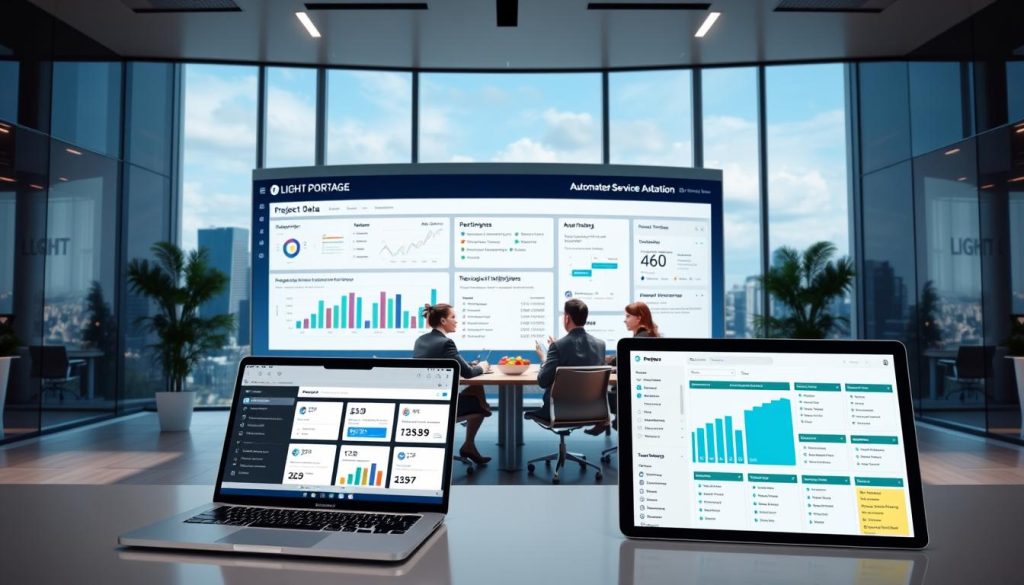When Marie left a large firm to work on her own in Paris, she feared slow months and unclear scope. She found stability by shaping repeatable offerings that tied tech fixes to clear business outcomes. This change cut delivery time and built trust with customers.
We show how a services-first model bridges technology and client goals. The focus is on lifecycle engagement, not one-off tasks. That approach helps you turn expertise into a steady income while protecting your reputation in France’s market.
Teams and firms use simple frameworks to set expectations, manage scope, and prove value at each phase. You will learn how to build a resilient portfolio—consultation, design, activation, and integration—so your work stays predictable and high quality.
For a deeper playbook on turning guidance into steady revenue, see our professional services guide.
Table of Contents
Key Takeaways
- Clear, repeatable offerings protect income and margins.
- Outcome-focused work links tech changes to measurable value.
- Lifecycle engagement reduces time to results and builds loyalty.
- Structured delivery keeps quality steady across projects.
- Communicate value in business terms to win and retain customers.
What Are Professional Services Today?
Knowledge-driven occupations anchor modern advisory work across firms and solo practices.
Definitions and scope. These offerings rely on certified training and judgment. Typical occupations include architects, accountants, engineers, lawyers, doctors, consultants, and IT specialists. Supply can come from sole proprietors, partnerships, or corporations, depending on skill, reputation, and client needs.
Firm types at a glance. Von Nordenflycht’s taxonomy helps you benchmark where you sit. Each model differs by capital intensity, workforce professionalization, and how value is produced.
| Firm Type | Knowledge Intensity | Capital Intensity | Typical Examples |
|---|---|---|---|
| Classic PSFs | High | Low | Law firms, accounting firms |
| Professional campuses | High | High | Hospitals, large clinics |
| Neo-PSFs | High | Low | Management consultancies, boutique IT firms |
| Technology developers | High | High | R&D labs, biotech companies |
Value beyond products. People create trust, discretion, and bespoke outcomes. Clients buy verified expertise and clear scope more than a commodity. For independents in France, aligning skills to client goals and updating expertise keeps your offering relevant in the services industry.
The Core Pillars of Professional Services
A clear set of pillars turns complex client needs into repeatable, measurable work. These four disciplines guide how we capture knowledge, shape offerings, deliver outcomes, and keep the customer experience coherent.
Consultation: Strategic discovery that shapes outcomes
Listen first, design second. Consultation is a structured discovery that captures goals, constraints, and risks. It translates knowledge into a prioritized roadmap your customers can trust.
Service Design: Crafting offerings aligned to client needs
Design shapes offerings around explicit needs and capacity. Scope, timelines, and resources are aligned so your team can deliver consistently and responsibly.
Implementation and Activation: Turning plans into measurable value
This phase configures, tests, and enables solutions. Measurable value appears within an agreed time frame by sequencing quick wins and validating results.
Service Integration: Orchestrating products, platforms, and support
Integration ensures products, platforms, and support work together. It protects the customer experience, reduces friction, and drives adoption through governance and metrics.
- What customers get: clear inclusions, delivery steps, and value checkpoints.
- How delivery stays on track: project governance, cadence, and documentation.
- Team alignment: defined roles, responsibilities, and escalation paths early in the project.
| Pillar | Primary Focus | Team Output | Customer Outcome |
|---|---|---|---|
| Consultation | Strategic listening, risk capture | Prioritized roadmap | Clarity on goals and next steps |
| Service Design | Offer shaping, capacity planning | Scoped offerings and timelines | Predictable delivery and expectations |
| Implementation & Activation | Configuration, testing, enablement | Validated deployments and quick wins | Measurable value within time targets |
| Integration | Orchestration, support alignment | Coordinated platforms and docs | Sustained adoption and better experience |
For a practical template on presenting offerings and keeping delivery reliable, see our structured offerings guide.
Inside the Professional Services Industry
The market now groups advisory firms by how they mix capital, know-how, and repeatable delivery.
Taxonomy and structure. Von Nordenflycht’s framework separates Classic PSFs, neo-PSFs, professional campuses, and technology developers by capital and knowledge intensity. This map helps you compare your practice to other firms in the industry.
From one-off work to outcome-driven models. Many businesses shift from product-first engagements to a services-first approach that ties pricing and delivery to outcomes. Subscriptions and lifecycle contracts now stabilize revenue and increase retention.
- Recurring models align pricing to measurable impact.
- Technology roadmaps shape how offers complement a core product.
- Knowledge management scales what works across engagements.
| Firm Type | Capital Intensity | Knowledge Intensity | Typical Business Model |
|---|---|---|---|
| Classic PSFs | Low | High | Hourly engagements, retained advice |
| Neo-PSFs | Low | High | Outcome-based projects, packages |
| Professional campuses | High | High | Integrated care/education, long-term contracts |
| Technology developers | High | High | Product-led with attached subscriptions |
Procurement expectations. In France, buyers ask for references, clear scopes, and fair pricing tied to concrete needs and risks. Adopting transparent guardrails improves trust and speeds procurement.
Examples of Professional Services Across Industries

Real-world examples show how targeted offerings solve common risks and unlock value for clients.
Technology and data
IT consulting, cybersecurity consulting, software development, and data analytics dominate demand. Technology & IT consulting made up about 31% of global professional offerings sold in 2022.
These examples professional align well with skills in cloud, DevOps, machine learning, and secure architecture.
Business and strategy
Management consulting, M&A advisory, and risk management help leaders decide and act. We focus on outcomes such as cost reduction, deal certainty, and continuity.
Design and engineering
Architecture, engineering, QA, and sustainability consulting ensure compliance and resilience. Firms sell scoped packages that combine audits, design, and implementation oversight.
People and operations
HR consulting, training and development, and executive coaching improve adoption and performance at work. These offerings increase retention and capability across teams.
Regulatory and legal
IP, immigration, customs and trade, plus occupational health safety advisory reduce exposure and meet timelines. Accuracy and documented assurance matter most to clients and customers.
« Clear, scoped offerings help you win procurement processes and protect margins. »
| Category | Common Examples | Client Outcome |
|---|---|---|
| Technology & Data | IT consulting, cybersecurity, software, analytics | Faster delivery, lower breach risk |
| Business & Strategy | Management consulting, M&A advisory, risk | Better decisions, deal certainty |
| Design & Engineering | Architecture, engineering, QA, sustainability | Compliance, long-term resilience |
| People & Ops | HR, training, executive coaching | Higher adoption, improved performance |
| Regulatory & Legal | IP, immigration, customs, health safety | Reduced exposure, contractual assurance |
How to use these examples: package offerings to cross industries, keep scope clear, and highlight measurable gains—risk reduction, continuity, and strategic value—to reach buyers in France and abroad.
How Service Delivery Works: Models, Pricing, and Billable Hours
Engagement choices—fixed, hourly, or outcome-based—drive project governance and billing rhythm. Picking the right approach helps you balance risk, clarity, and cash flow for each client engagement.
Engagement models
Fixed scope suits well-defined projects. You quote a price, set milestones, and protect margin with clear change control.
Time and materials fits uncertain work. You bill hours by seniority and keep invoices tied to recorded time.
Outcome-based links fees to results. It can raise rewards but requires solid metrics and procurement alignment.
Pricing strategies and communication
Combine rates, milestones, and success criteria to connect fees to business outcomes. Use empathy and firmness when explaining scope and change control.
For a deeper guide to tactics, see our pricing strategies.
Billable hours, utilization, and cash flow dynamics
Track billable hours and utilization to forecast revenue and protect cash flow. A small, focused team plus light PSA software keeps time capture and margin visibility accurate.
Set invoicing cadence, retention, and clear payment terms to shorten DSO and reduce disputes. Agree on work boundaries early to preserve well-being when hours spike.
Technology in Professional Services: PSA Software and Automation

Cloud-based systems now serve as the single source of truth for project, resource, and billing data.
What is Professional Services Automation (PSA)?
PSA is specialized software that automates core work: resource planning, time and expense, invoicing, and margin tracking. It becomes the system of record for professional services and for teams that want predictable service delivery.
Resource planning, project management, and financials in one system
By connecting staffing, schedules, and costs, PSA lets you spot risk early. Dashboards show utilization, backlog, and forecasted revenue so you can plan calmly instead of firefighting.
AI and automation use cases in delivery and decision-making
- Automated resourcing suggestions and schedule optimization.
- Risk alerts and document generation to save time.
- Integration with product platforms so implementation and support flow into one view.
« Removing friction in delivery helps customers get faster results and clearer accountability. »
| Feature | Benefit | Why it matters |
|---|---|---|
| Resource planning | Better match of skills to demand | Reduce bench time and overrun risk |
| Financials & pricing | Standardized rate cards and audit trails | Protect margin and trust |
| AI automation | Forecasting and alerts | Improve decision quality and speed |
professional services Challenges and Future Trends
Alignment gaps across functions are a common root cause of missed outcomes and extra rework. Teams often track activity instead of value, which slows time-to-impact for customers. Resetting KPIs to reward outcomes, customer success, and shorter time-to-value helps fix that.
Alignment, standardized methods, and KPI relevance
Why it matters: misaligned metrics create rework and weak decisions. Adopt standard methods and clear checkpoints so your team can deliver repeatable value.
Talent, capacity planning, and blended delivery models
Use a blended model—core people, vetted partners, and flexible contracts—to scale without harming quality. Simple weekly checks on capacity and quarterly planning reduce risk and burnout.
AI, data-driven work, remote collaboration, and DCX
AI and automation accelerate routine tasks and surface insights, but judgment remains central. Pair automation with training and documented safeguards so decisions stay transparent.
Remote rituals and clear handoffs keep teams connected and protect the customer experience across channels.
Market momentum: growth drivers and sector mix
The global market was valued at USD 6.02T in 2022 and is set to exceed USD 10.17T by 2031. Technology and IT consulting made up roughly 31% of demand in 2022. These trends mean targeted investments in talent, tooling, and training will yield measurable returns for businesses focused on value and time-to-success.
« Standardized methods and pragmatic training protect quality and help firms scale with confidence. »
Conclusion
A resilient practice ties clear offerings to measurable gains and a steady cash flow.
The market is shifting toward outcome-based and subscription models that reward lifecycle value. Align KPIs to outcomes, use PSA and automation to save time, and document delivery so customers see progress.
Invest in light systems and ongoing training to protect margins, cut hours leakage, and improve pricing clarity. Package your work into digestible offerings and keep a short list of examples professional that prove relevance in France and beyond.
Stay close to customers, refine your model as needs change, and prioritize quality. Do this and your firms, professionals, and businesses will sustain trust, growth, and long-term success.
FAQ
What do you mean by "professional services" today?
We refer to knowledge-intensive firms and occupations that combine specialized expertise, advisory skills, and project delivery to solve client problems. These offerings often go beyond a product — they include strategy, design, implementation, and ongoing support to create measurable outcomes and protect client investments.
How do these firms create value beyond selling products?
Value comes from translating technical or business know-how into tangible results: reduced risk, improved performance, faster time to value, and sustained customer success. Firms do this through discovery, tailored solutions, disciplined delivery, and ongoing lifecycle engagement.
What are the core pillars of a strong offering?
A complete offering rests on four pillars: consultation for strategic discovery, service design that aligns to needs, implementation that delivers measurable outcomes, and integration that ties products, platforms, and support into a coherent solution.
Which engagement models do firms commonly use?
Common models include fixed-scope engagements, time-and-materials contracts, and outcome-based agreements. Each balances risk and reward differently and should match client goals, timeline, and governance preferences.
How should I choose a pricing strategy for my projects?
Choose pricing by assessing value delivered, client willingness to pay, and internal cost-to-serve. Communicate value through clear KPIs and scope. Mix models where helpful—retainers for continuity, fixed price for well-defined work, and outcomes-based for transformative projects.
What is billable hours utilization and why does it matter?
Utilization measures the share of time staff spend on revenue-generating work. It drives cash flow and profitability. Managing utilization with realistic project planning, capacity buffers, and efficient resource allocation reduces burn and improves margins.
What is Professional Services Automation (PSA) and when should I implement it?
PSA is software that unifies resource planning, project management, time and expense tracking, and financials. Implement PSA when growth creates complexity in scheduling, billing, and forecasting — it improves visibility, reduces administrative friction, and supports scalable delivery.
How can AI and automation help delivery and decision-making?
AI speeds routine tasks like forecasting, skills matching, and status reporting. Automation reduces manual billing, enforces workflows, and surfaces risks early. Together they free expert time for higher-value work and support faster, data-driven decisions.
What talent and capacity challenges should I expect?
Expect fluctuations in demand, skills gaps for new technologies, and competition for senior talent. Effective capacity planning, blended delivery models (onsite, remote, subcontractors), and continuous upskilling help manage risk and maintain quality.
How are business models shifting in the industry?
Many firms move from one-off projects to subscription and lifecycle models that align incentives with long-term outcomes. This shift improves recurring revenue, customer retention, and the ability to invest in proactive support and product integration.
Can you give examples of services across industries?
Examples include IT consulting and cybersecurity in technology, management consulting and M&A advisory in business strategy, architectural and engineering design, HR and executive coaching in people operations, and legal advice like IP and customs compliance.
How do I measure success and choose the right KPIs?
Select KPIs tied to client outcomes and commercial health: project ROI, time-to-value, utilization, renewal rates, and cash flow. Ensure methods are standardized enough to compare performance but flexible for unique client contexts.
What market trends will affect the next five years?
Look for increased AI adoption, data-driven delivery, remote collaboration, outcome-based contracting, and continued migration to subscription models. These trends will reshape pricing, talent needs, and the design of offerings.





